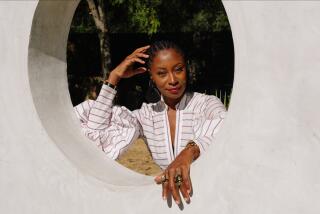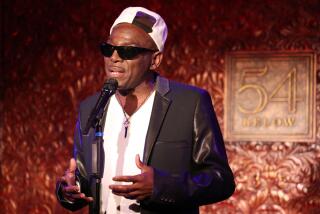Review: Missing the Martha in Martha Graham Dance
Celebrating Martha Graham’s commitment to new American music, an ambitious five-part program at the Valley Performing Arts Center in Northridge on Saturday found the Graham Dance Company accompanied and outclassed by Christopher Rountree’s chamber orchestra wild Up. The problem: passion that could be heard but rarely seen.
Twenty-six years after Graham’s death, company Artistic Director Janet Eilber has trivialized Graham style by bypassing the late choreographer’s unique body sculpture in favor of picture-perfect lineups, well drilled unison footwork and brisk athleticism — a reassuring professionalism that’s often all you get in the lighter works. Movement that should come from deep within the back or torso seldom does, and this superficial physicality often causes severe expressive consequences.
Graham said executing her movement fully and completely gave a dancer the intensity needed for a particular role. With that priority neglected, shallow moves inevitably generated shallow emotions, and that’s one reason why the power in wild Up’s playing kept reminding you of exactly what was missing on the stage.
Graham’s “Dark Meadow” (1946) was originally a challenging, immersive, 50-minute ritual linked to the ancient Greek myth of Persephone. In Graham’s lifetime she reportedly allowed only the “Sarabande” section to be excerpted. But on Saturday the company offered Eilber’s 20-minute suite of what she called “highlights” — over the objections of the Graham estate. Led by Anne O’Donnell and Lorenzo Pagano, the dancing stayed grimly dutiful, and a sense of the work’s obsessive fervor could be found only in wild Up’s playing of Carlos Chavez’s score and, in particular, Andrew Tholl’s soulful violin solos.
Based on Euripides’ tragedy “Medea,” the dance drama “Cave of the Heart” (1946) offers a timely warning about the dangers of underestimating wronged women and immigrants. (Medea belongs to both categories.) Wild Up’s mastery of the surging Samuel Barber music may have represented the ensemble’s most indelible achievement on Saturday, and periodically the dancers rose to the occasion — especially Ben Schultz as the heroic, heedless, self-infatuated Jason: a monument ripe for demolition. If you looked closely, Xin Ying’s small-scale interpretation of Medea had venom aplenty, and Natasha Diamond-Walker gesticulated forcefully as the harbinger of doom. As Jason’s new trophy wife, Charlotte Landreau proved doubly victimized, first by Jason’s chauvinism, then by Medea’s poisoned crown.
Two large-scale plotless showpieces zoomed by in a blur of compromised dance technique and spot-on musicianship. Danced to a score by Norman Dello Joio, the Eilberized “Diversion of Angels” (1948) largely erased the intended distinctions between three leading couples, though the high-speed bravery of Laurel Dalley Smith and the regal serenity of Leslie Andrea Williams kept you watching. Bland again, O’Donnell at least provided samples of the iconic Graham torso-contractions in short supply on Saturday.
Graham’s last dance, “Maple Leaf Rag” (1990), featured wild Up pianist Richard Valitutto playing Scott Joplin, which might be enough for any audience. Here, however, Graham contributed mock-solemn self-parody plus a string of brisk corps excursions punctuated by Williams in a long white dress. Smith and Ari Mayzick were cast as the playful, gymnastic leads.
The evening began with 28 Cal State Northridge and community dancers presenting a reconstruction of three sections (or “themes”) from Graham’s 1935 “Panorama” to recorded music by Norman Lloyd. Geometric juxtapositions, simple actions heightened through forceful repetition, visual and percussive rhythms: What a declaration of creative independence this microcosm of society on the march represented, with Graham’s scarlet costumes enhancing her genius for forceful modernist spectacle.
SIGN UP for the free Essential Arts & Culture newsletter »
Support coverage of the SoCal arts scene. Share this article.
ALSO
Paul Taylor proves staying power of ‘70s and ‘80s dance
Choreographer Kyle Abraham on race, the MacArthur curse and dancing to Kendrick and Kanye
‘In the Steps of Trisha Brown,’ and the L.A. festival where dance and film collide
More to Read
The biggest entertainment stories
Get our big stories about Hollywood, film, television, music, arts, culture and more right in your inbox as soon as they publish.
You may occasionally receive promotional content from the Los Angeles Times.






